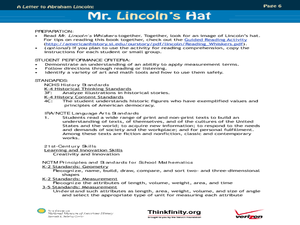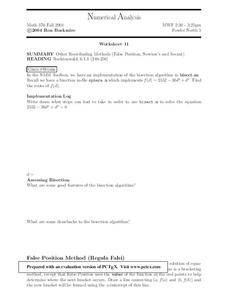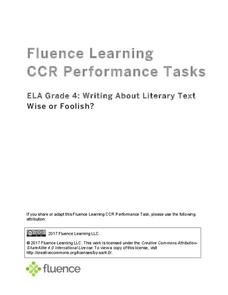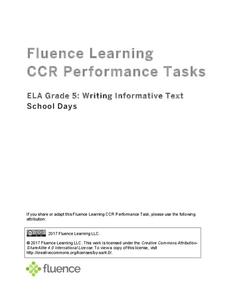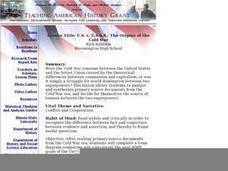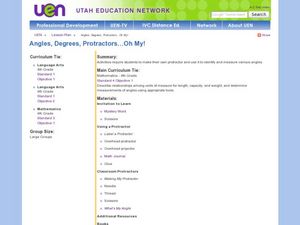Curated OER
Mr. Lincoln's Hat
Bring out the inner artist with this Abraham Lincoln lesson. Elementary students work on a home project creating a hat similar to Abraham Lincoln's hat. They will use geometry and measurement to create the scale of the hat, then...
Curated OER
Kitchen Math - Levels I & II
Learners examine mathematics as an important component of nutrition management and food preparation.
Curated OER
The Mitten
Explore the Ukraine through a reading of The Mitten. Readers will determine the sequence of events, cause and effect, make predictions, and find the main idea of the story. They also use math skills to make charts and graphs. Finally,...
Curated OER
Destination Outer Space
Students investigate space travel. In this space travel lesson students examine space exploration history, engineers and scientists involved in space exploration, and Newton's third law of motion. Students make rockets.
Curated OER
Taxing Taxes
Students complete math word problems. For this taxes lesson, students discuss taxes and why they are necessary. Students research the history of taxes, write a summary of their findings, determine the sales tax in their area and...
Curated OER
Numerical Analysis/ Other Root-finding Methods
In this math worksheet, students examine the uses of false position, Newton’s and Secant methods of finding the root of an equation.
Teach Engineering
Who Can Make the Best Coordinate System?
Working with a map that does not have a coordinate system on it, small, collaborative teams must come up with a coordinate system for their map. Groups then explain their coordinate structure to the class.
Fluence Learning
Writing About Literary Text: Wise or Foolish?
A three-part assessment promotes reading comprehension skills. Class members read literary texts and take notes to discuss their findings, answer comprehension questions, write summaries, and complete charts.
Fluence Learning
Writing Informative Text: School Days
A three-part writing assessment challenges scholars to think critically about schools of the past and present. Learners read informative texts, answer questions to prepare for a discussion, research in small groups, complete a Venn...
Teach Engineering
Weather Forecasting
According to the Farmers' Almanac, the weather will be nice today. Class members examine how weather forecasting plays a part in their lives with a resource that provides information on the history of forecasting, from using cloud...
Curated OER
Tour of the Solar System
Learners engage in science, math, and language activities as they do research on the components of the solar system. The class begins with some anticipatory activities and discussions before it is divided into small groups to conduct...
Curated OER
Math: Christmas Count Down
Students use various tools to calculate the number of days before Christmas. Among the tools are number lines, calendars, and the Internet. Each day, a student visits a Christmas Countdown Website to report the days left. At the end of...
Curated OER
Pi Day
Ninth graders explore the concept of pi in preparation for developing a project for pi day. They examine direct variation, the history of pi, circle circumference and arc length, area and sector area and then consider how these concepts...
Curated OER
Chance (Probability) Operations in Dance Composition -
Eighth graders investigate modern-dance choreographer Merce Cunningham's historically significant contribution to dance-making history. Specifically, 8th graders explore and practice Merce Cunningham's choreographic use of chance...
Curated OER
Kites: Patang - The Indian Fighter Kite
Students investigate the history of fighter kites and build their own. In this aeronautics lesson, students discover how other countries utilize fighter kites and where they originated. Students create their own fighter kites in class...
Curated OER
Lesson 3: Where Does Money Come From?
Students listen to story Hundred Penny Box by Sharon Bell Mathis, explore history of money, and examine how money is produced in the United States. They discuss why money is used for exchange, and describe how money has changed over time.
Curated OER
Linear Equations Project Fram
Students engage in a lesson that focuses on the concept of linear equations. They practice solving problems with a variety of problems and graphing the solution set for each. Students write a summary paragraph about two methods of...
Curated OER
Linking Kwanzaa to Technology and History
Seventh graders use the Internet to research the holiday of Kwanzaa. Using the information, they create a brochure to promote the holiday to others. They email the information to a friend to end the lesson.
Curated OER
Kitchen Math - Levels I & II
Identify appropriate abbreviations, food-measurement terminology, techniques, equivalents, and calculate recipe-size adjustments and demonstrate proper measuring techniques. Identify abbreviations Compute equivalents Identify measuring...
Curated OER
Interactive Timeline
Young scholars examine the development of ragtime music and its relation to jazz. They participate in an online Interactive timeline and read about the history of ragtime music, listen to examples of music, and in small groups create...
Utah Education Network (UEN)
Angles, Degrees, Protractors . . . Oh My!
Fourth and fifth graders make a protractor and identify various angle types. In this protractor and angle lesson, learners make their own protractor and use it to measure a variety of angles. They complete worksheets while identifying...
Curated OER
Area of Tangram Pieces
Mathematicians calculate the area of a tangram piece without using formulas. They use a geometry journal to record activities during this lesson. They make a set of tangrams and use them to compute area. They use what they discover to...
University of California
Euclidean Geometry
Go back to where it all began! Investigate how axiomatic systems and Euclidean geometry are based on undefined terms, common notions, postulates, and propositions by examining passages from Euclid's Elements. (Social studies teachers...
Curated OER
Creating a Thematic Map
Students create and analyze a weather-related data table and a thematic map based upon information provided.


